engine MITSUBISHI ECLIPSE CROSS 2019 Owner's Manual (in English)
[x] Cancel search | Manufacturer: MITSUBISHI, Model Year: 2019, Model line: ECLIPSE CROSS, Model: MITSUBISHI ECLIPSE CROSS 2019Pages: 423, PDF Size: 75.41 MB
Page 387 of 423

Fuses 9-26 Vehicle care and maintenance
9
N00954901167
1. Before replacing a fuse, always turn off the electrical item connected to the fuse and turn the ignition switch to the “OFF”position or put the operation mode in OFF. 2. There is a fuse remover (A) in the enginecompartment fuse block.
3. Clamp it on the fuse you wish to remove, and pull the fuse straight out from the fuseblock. 4. Use the fuse location diagrams and the matching tables, to check the fuse that is related to the problem. If the fuse is not blown, something else must be causingthe problem. Have the system inspectedby your authorized Mitsubishi Motors dealer or a repair facility of your choice.
5. Insert a new fuse of the same capacity securely into the appropriate slot.
Identification of fuse Capacity
Color
7.5 A Brown10 A Red15 A Blue20 A Yellow25 A Natural (white) 30 A
Green (fuse type) / Pink (fusible link type)
40 A Green (fusible link type)
Fuse replacement
B- Fuse is OK C- Blown fuseCAUTION Never use a fuse with a capacity greater than the one listed or any substitute, such as wire, foil etc. This would cause the circuit wiring to heat up and could cause a fire. If the replacement fuse blows again after a short time, have the electrical systemchecked by an authorized Mitsubishi Motors dealer or a repair faci
lity of your choice to
find and correct the cause.
BK0266800US.bo
ok 26 ページ 2018年6月27日 水曜日 午後5時6分
Page 398 of 423

Cleaning the outside of your vehicle Vehicle care and maintenance 9-37
9
N00945901712
Chemicals contained in the dirt and dust picked up from air, rain, snow, or road sur-faces can damage the paint and body of your vehicle if left on. Frequent washing and waxing is the best wayto protect your vehicle from this damage. Do not wash the vehicle in direct sunlight. Park the vehicle in the shade and spray it withwater to remove dust. Next, using plenty ofclean water and a car washing mitt or sponge, wash the vehicle from top to bottom. Use a mild car washing soap if necessary.Rinse thoroughly and wipe dry with a cham- ois or soft cloth. After washing the vehicle, carefully clean the joints and flanges of thedoors, hood, etc., where dirt is likely to remain.
Salt and other chemicals
used on winter roads
in some geographical areas can have a detri- mental effect on the vehicle underbody. You should flush the underbody with a high pres-sure hose every time you wash the outside of your vehicle. Take special care to remove mud or otherdebris which could trap and hold salt and moisture. After washing your vehicle, wipe off allwaterdrops from the rubber parts around the doors to prevent the doors from freezing.
Wa s h i n g
CAUTION When washing the underside of your vehicle or the wheels, wear a pair of gloves to pro-tect your hands. If your vehicle is equipped with the rain sen- sor, place the wiper switch lever in the “OFF” position to deactivate the rain sensorbefore washing the vehicle. Otherwise, the wipers will operate in the presence of water spray on the windshield and may get dam-aged as a result.
Never spray or splash water on the electrical parts in the engine compartment. This may damage them. Be careful also when washing the underbody to ensure that water does not enter the engine compartment. Avoid automatic car washes that use rotating brushes. These brushes may scratch the paintsurface and make it dull. Scratches are more noticeable on darker col- ored vehicles. Some hot water washing equipment uses high pressure and heat
to clean your vehicle.
Because hot water can damage plastic parts and seep inside your vehicle, make sure you do the following when using such equip-ment:• Keep the washing nozzle at least 28 inches(70 cm) away from the vehicle body.• When washing around the door glass, holdthe nozzle at a distance of more than 28 inches (70 cm) and at a right angle to the glass surface.
Make sure to do the following when using an automatic car wash, with help from eitherthis manual or the car wash operator, to avoid damaging your vehicle:• Fold the outside rearview mirrors.• Close the door windows.• Close the front sunroof (if so equipped)• Tape or remove the rear wiper arm assem- bly.CAUTION
• As your vehicle is equipped with the roof spoiler and the rear spoiler, check with the car wash operator before using the car wash.• If your vehicle is equipped with roof rails,check with the car wash operator before using the car wash.• If your vehicle is equipped with the rainsensor, place the wiper switch lever in the“OFF” position to deactivate the rain sen- sor.
During cold weather
CAUTION
BK0266800US.bo
ok 37 ページ 2018年6月27日 水曜日 午後5時6分
Page 400 of 423
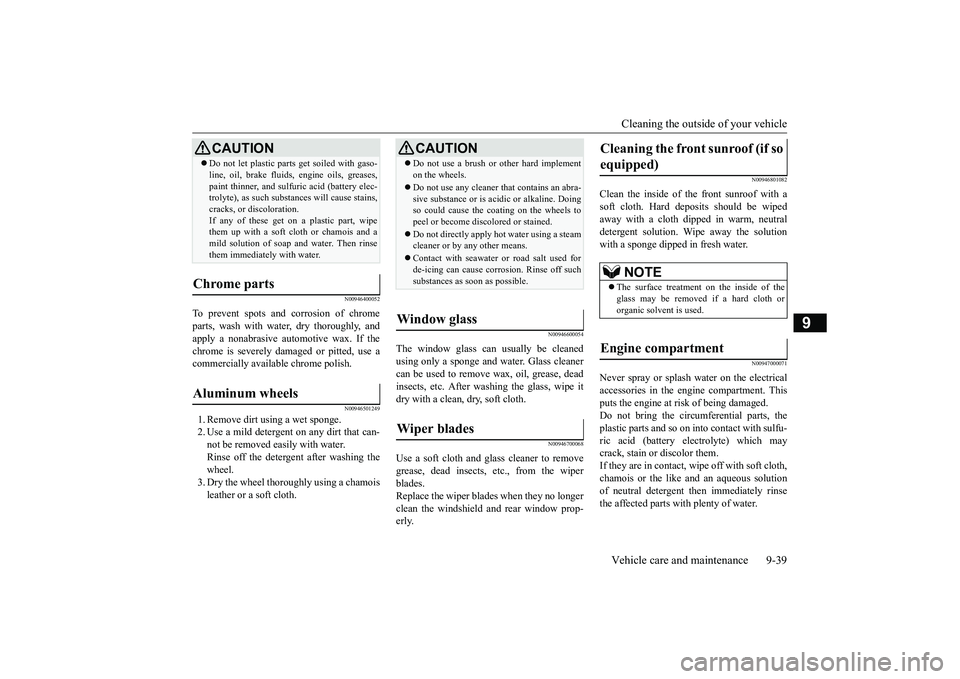
Cleaning the outside of your vehicle Vehicle care and maintenance 9-39
9
N00946400052
To prevent spots and corrosion of chrome parts, wash with water, dry thoroughly, and apply a nonabrasive automotive wax. If thechrome is severely damaged or pitted, use a commercially available chrome polish.
N00946501249
1. Remove dirt using a wet sponge.2. Use a mild detergent on any dirt that can- not be removed easily with water.Rinse off the detergent after washing the wheel. 3. Dry the wheel thoroug
hly using a chamois
leather or a soft cloth.
N00946600054
The window glass can usually be cleanedusing only a sponge and water. Glass cleaner can be used to remove wax, oil, grease, dead insects, etc. After washing the glass, wipe itdry with a clean, dry, soft cloth.
N00946700068
Use a soft cloth and glass cleaner to removegrease, dead insects, etc., from the wiper blades. Replace the wiper blades when they no longerclean the windshield and rear window prop- erly.
N00946801082
Clean the inside of the front sunroof with a soft cloth. Hard deposits should be wiped away with a cloth dipped in warm, neutral detergent solution. Wipe away the solutionwith a sponge dipped in fresh water.
N00947000071
Never spray or splash water on the electricalaccessories in the engine compartment. This puts the engine at risk of being damaged. Do not bring the circumferential parts, theplastic parts and so on into contact with sulfu- ric acid (battery electrolyte) which may crack, stain or discolor them.If they are in contact, wipe off with soft cloth, chamois or the like and an aqueous solution of neutral detergent then immediately rinsethe affected parts with plenty of water.
Do not let plastic parts get soiled with gaso- line, oil, brake fluids
, engine oils, greases,
paint thinner, and sulfuric acid (battery elec- trolyte), as such substances will cause stains, cracks, or discoloration.If any of these get on a plastic part, wipe them up with a soft cloth or chamois and a mild solution of soap and water. Then rinsethem immediately with water.
Chrome parts Aluminum wheels
CAUTION
CAUTION Do not use a brush or other hard implement on the wheels. Do not use any cleaner that contains an abra- sive substance or is acidic or alkaline. Doingso could cause the coating on the wheels to peel or become discolored or stained. Do not directly apply hot water using a steam cleaner or by any other means. Contact with seawater or road salt used for de-icing can cause corrosion. Rinse off such substances as soon as possible.
Window glass Wiper blades
Cleaning the front sunroof (if so equipped)
NOTE
The surface treatment on the inside of the glass may be removed if a hard cloth or organic solvent is used.
Engine compartment
BK0266800US.bo
ok 39 ページ 2018年6月27日 水曜日 午後5時6分
Page 408 of 423
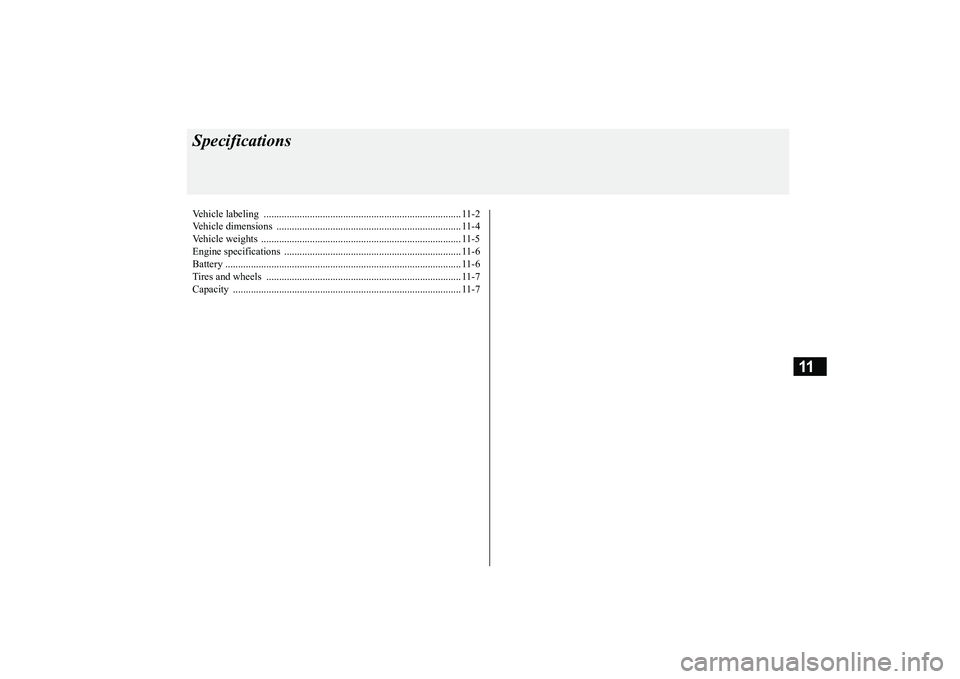
11
SpecificationsVehicle labeling ....
.................................................
........................ 11-2
Vehicle dimensions
................................................
........................ 11-4
Vehicle weights ...............
............................................................... 11-5
Engine specifications
.............................................
........................ 11-6
Battery .......................................
..................................................... 11-6
Tires and wheels .............
............................................................... 11-7
Capacity ....................................
..................................................... 11-7
BK0266800US.bo
ok 1 ページ 2018年6月27日 水曜日 午後5時6分
Page 409 of 423
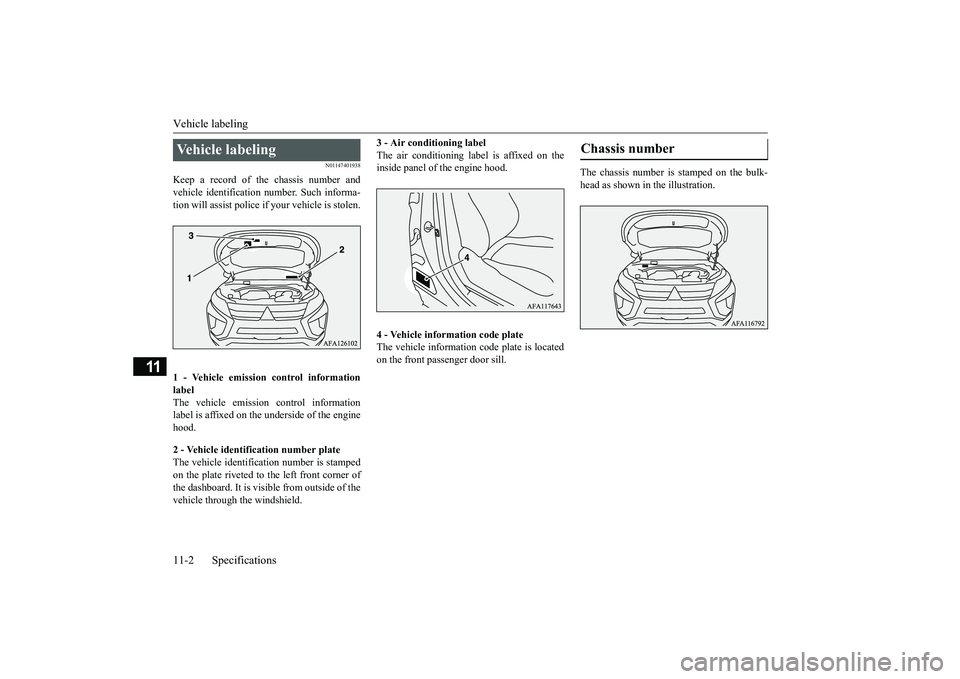
Vehicle labeling 11-2 Specifications
11
N01147401938
Keep a record of the chassis number and vehicle identification number. Such informa-tion will assist police if your vehicle is stolen. 1 - Vehicle emission control information label The vehicle emission control informationlabel is affixed on the underside of the engine hood. 2 - Vehicle identification number plate The vehicle identification number is stampedon the plate riveted to the left front corner of the dashboard. It is visible from outside of the vehicle through the windshield.
3 - Air conditioning label The air conditioning label is affixed on the inside panel of the engine hood. 4 - Vehicle information code plate The vehicle information code plate is locatedon the front passenger door sill.
The chassis number is stamped on the bulk- head as shown in the illustration.
Vehicle labeling
Chassis number
BK0266800US.bo
ok 2 ページ 2018年6月27日 水曜日 午後5時6分
Page 410 of 423
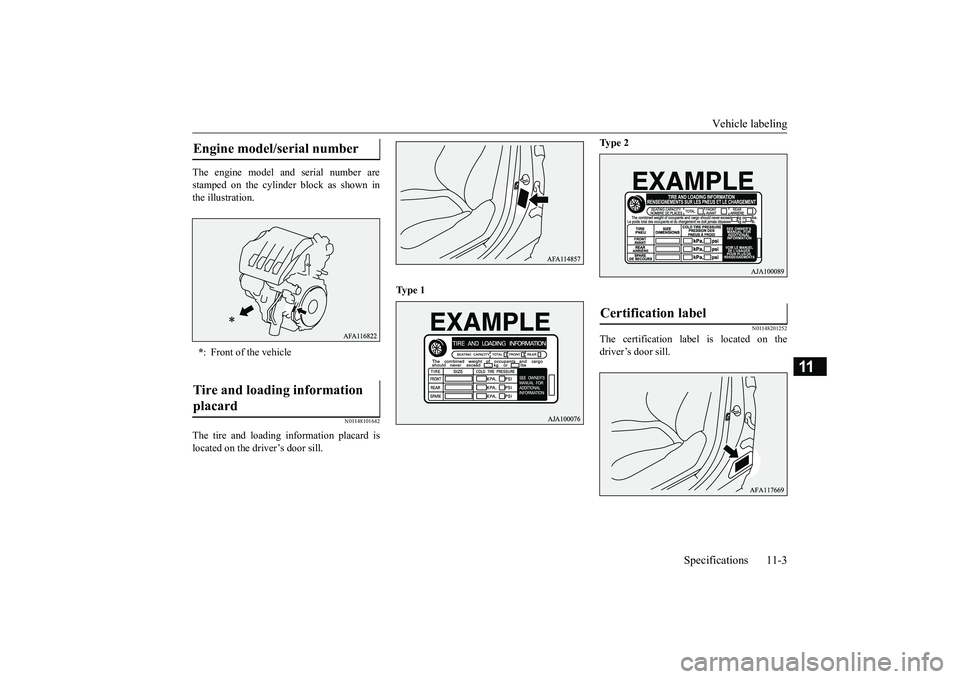
Vehicle labeling
Specifications 11-3
11
The engine model and serial number are stamped on the cylinder block as shown in the illustration.
N01148101642
The tire and loading information placard is located on the driver’s door sill.
Ty p e 1
Ty p e 2
N01148201252
The certification label is located on the driver’s door sill.
Engine model/serial number * : Front of the vehicleTire and loading information placard
Certification label
BK0266800US.bo
ok 3 ページ 2018年6月27日 水曜日 午後5時6分
Page 413 of 423
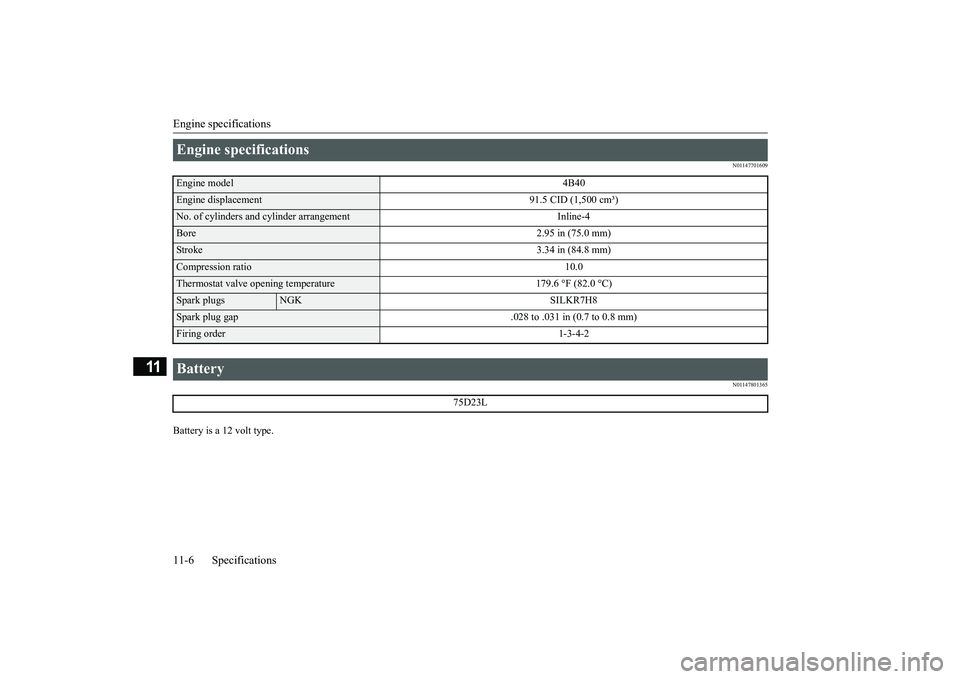
Engine specifications 11-6 Specifications
11
N01147701609 N01147801365
Battery is a 12 volt type.Engine specifications Engine model
4B40
Engine displacement 91.5 CID (1,500 cm³)No. of cylinders and cylinder arrangement Inline-4Bore
2.95 in (75.0 mm)
Stroke
3.34 in (84.8 mm)
Compression ratio 10.0Thermostat valve opening temperature 179.6 °F (82.0 °C)Spark plugs
NGK SILKR7H8
Spark plug gap .028 to .031 in (0.7 to 0.8 mm)Firing order
1-3-4-2
Battery
75D23L
BK0266800US.bo
ok 6 ページ 2018年6月27日 水曜日 午後5時6分
Page 414 of 423
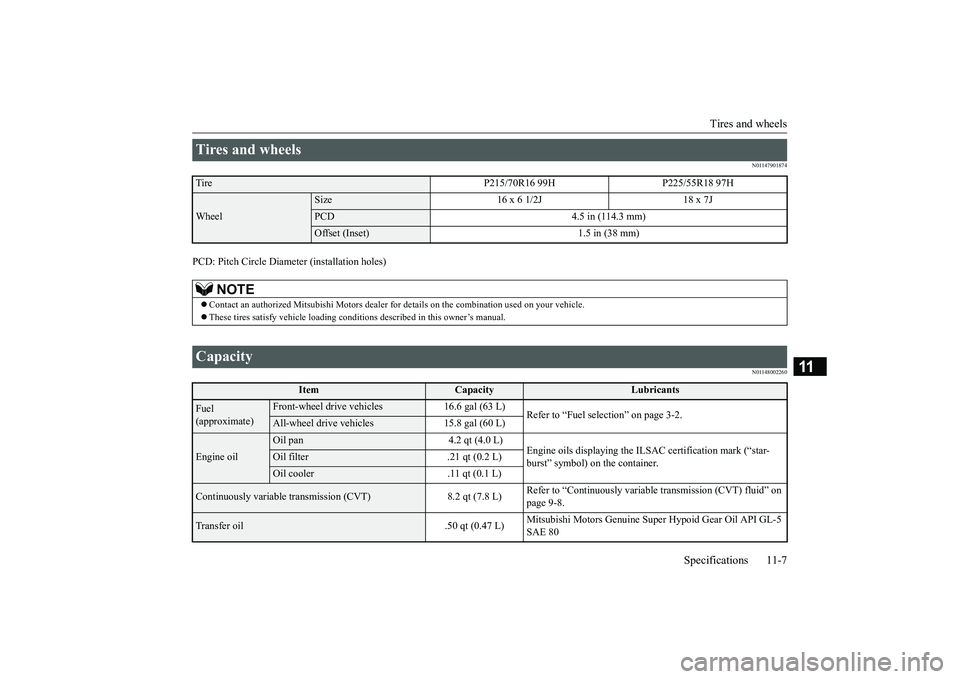
Tires and wheels
Specifications 11-7
11
N01147901874
PCD: Pitch Circle Diameter (installation holes)
N01148002260
Tires and wheels Tire P215/70R16 99H P225/55R18 97HWheel
Size 16 x 6 1/2J 18 x 7JPCD 4.5 in (114.3 mm)Offset (Inset) 1.5 in (38 mm)
NOTE
Contact an authorized Mitsubishi Motors dealer
for details on the combination used on your vehicle.
These tires satisfy vehicle loading cond
itions described in this owner’s manual.
Capacity
Item
Capacity
Lubricants
Fuel (approximate)
Front-wheel drive vehicles 16.6 gal (63 L)
Refer to “Fuel selection” on page 3-2.
All-wheel drive vehicles 15.8 gal (60 L)
Engine oil
Oil pan 4.2 qt (4.0 L)
Engine oils displaying the ILSAC certification mark (“star- burst” symbol) on the container.
Oil filter .21 qt (0.2 L)Oil cooler .11 qt (0.1 L)
Continuously variable transmission (CVT) 8.2 qt (7.8 L)
Refer to “Continuously variable transmission (CVT) fluid” on page 9-8.
Transfer oil .50 qt (0.47 L)
Mitsubishi Motors Genuine Super Hypoid Gear Oil API GL-5 SAE 80
BK0266800US.bo
ok 7 ページ 2018年6月27日 水曜日 午後5時6分
Page 415 of 423
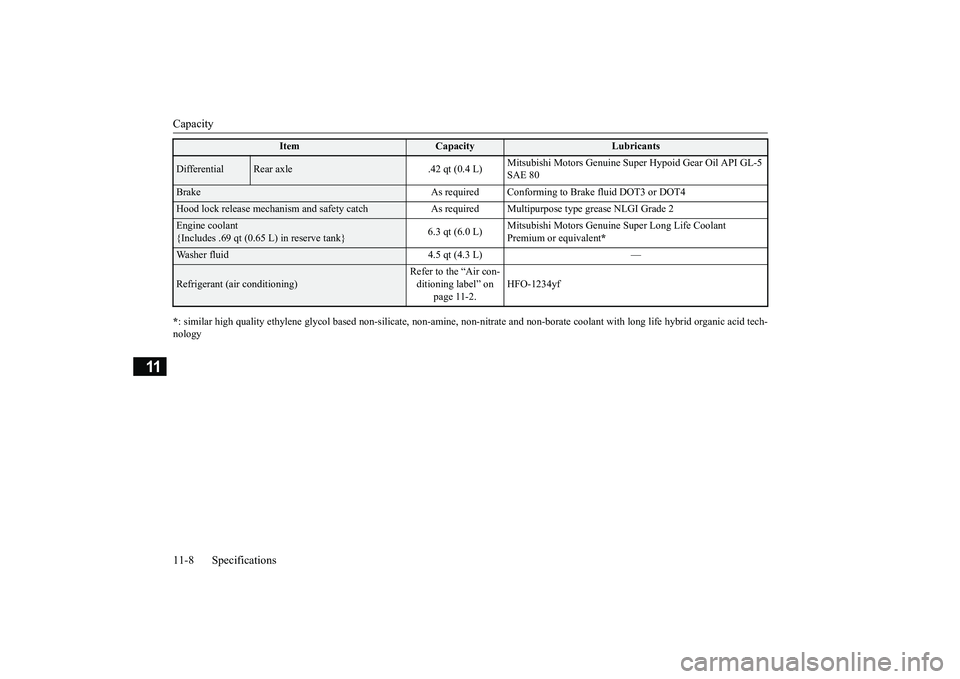
Capacity 11-8 Specifications
11
* : similar high quality ethylene glycol based non-silicate, non-am
ine, non-nitrate and non-borate
coolant with long life hybrid
organic acid tech-
nologyDifferential
Rear axle .42 qt (0.4 L)
Mitsubishi Motors Genuine Super Hypoid Gear Oil API GL-5 SAE 80
Brake As required Conforming to Brake fluid DOT3 or DOT4Hood lock release mechanism and safety catch As
required Multipurpose type grease NLGI Grade 2
Engine coolant {Includes .69 qt (0.65 L) in reserve tank}
6.3 qt (6.0 L)
Mitsubishi Motors Genuine Super Long Life Coolant Premium or equivalent
*
Washer fluid 4.5 qt (4.3 L) —Refrigerant (air conditioning)
Refer to the “Air con- ditioning label” on
page 11-2.
HFO-1234yf
Item
Capacity
Lubricants
BK0266800US.bo
ok 8 ページ 2018年6月27日 水曜日 午後5時6分
Page 417 of 423
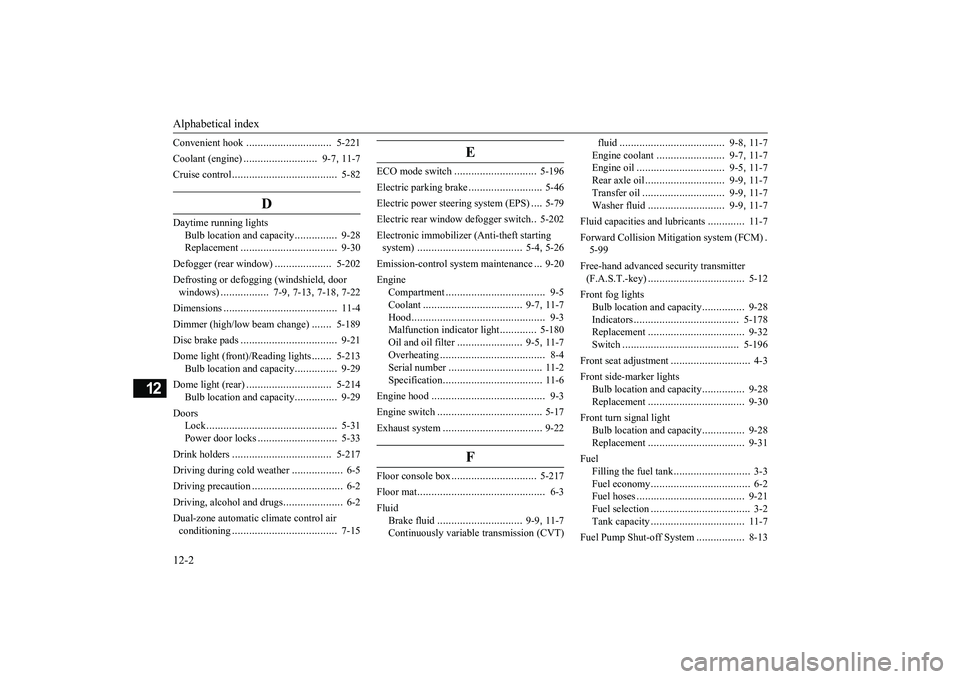
Alphabetical index 12-2
12
Convenient hook
...............
...............
5-221
Coolant (engine)
..........................
9-7
, 11-7
Cruise control
....................
.................
5-82
D
Daytime running lights
Bulb location and capacity
...............
9-28
Replacement
.................
.................
9-30
Defogger (rear window)
....................
5-202
Defrosting or defogging (windshield, door windows)
.................
7-9
, 7-13
, 7-18
, 7-22
Dimensions
...................
.....................
11-4
Dimmer (high/low beam change)
.......
5-189
Disc brake pads
.................
.................
9-21
Dome light (front)/Reading lights
.......
5-213
Bulb location and capacity
...............
9-29
Dome light (rear)
...............
...............
5-214
Bulb location and capacity
...............
9-29
Doors
Lock
......................
........................
5-31
Power door locks
............................
5-33
Drink holders
....................
...............
5-217
Driving during cold weather
..................
6-5
Driving precaution
................
................
6-2
Driving, alcohol and drugs
.....................
6-2
Dual-zone automatic climate control air conditioning
....................
.................
7-15
E
ECO mode switch
.............................
5-196
Electric parking brake
..........................
5-46
Electric power steering system (EPS)
....
5-79
Electric rear window defogger switch
..5-202
Electronic immobilizer (Anti-theft starting system)
.....................
................
5-4
, 5-26
Emission-control system maintenance
...
9-20
Engine
Compartment
..................
.................
9-5
Coolant
...................
................
9-7
, 11-7
Hood
.......................
........................
9-3
Malfunction indicator light
.............
5-180
Oil and oil filter
.......................
9-5
, 11-7
Overheating
....................
.................
8-4
Serial number
.................
................
11-2
Specification
...................
................
11-6
Engine hood
....................
....................
9-3
Engine switch
.....................
................
5-17
Exhaust system
...................
................
9-22
F
Floor console box
..............................
5-217
Floor mat
.........................
....................
6-3
Fluid
Brake fluid
..............................
9-9
, 11-7
Continuously variable transmission (CVT)
fluid
....................
.................
9-8
, 11-7
Engine coolant
........................
9-7
, 11-7
Engine oil
...............................
9-5
, 11-7
Rear axle oil
............................
9-9
, 11-7
Transfer oil
.............................
9-9
, 11-7
Washer fluid
...........................
9-9
, 11-7
Fluid capacities and lubricants
.............
11-7
Forward Collision Mitigation system (FCM)
.
5-99 Free-hand advanced security transmitter (F.A.S.T.-key)
.................
.................
5-12
Front fog lights
Bulb location and capacity
...............
9-28
Indicators
..................
...................
5-178
Replacement
.................
.................
9-32
Switch
......................
...................
5-196
Front seat adjustment
............................
4-3
Front side-marker lights
Bulb location and capacity
...............
9-28
Replacement
.................
.................
9-30
Front turn signal light
Bulb location and capacity
...............
9-28
Replacement
.................
.................
9-31
Fuel
Filling the fuel tank
...........................
3-3
Fuel economy
...................
................
6-2
Fuel hoses
.....................
.................
9-21
Fuel selection
...................
................
3-2
Tank capacity
................
.................
11-7
Fuel Pump Shut-off System
.................
8-13
BK0266800US.bo
ok 2 ページ 2018年6月27日 水曜日 午後5時6分